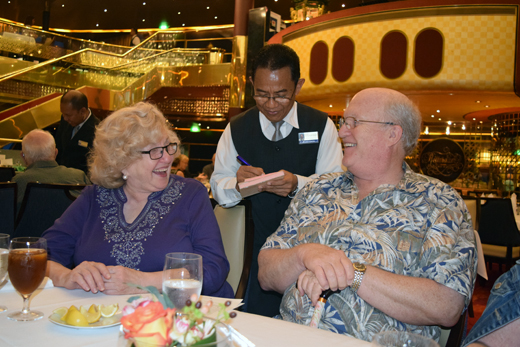
Editor’s Note: This is the 33rd in a series of stories researched during Don and Nancy Harrison’s 50th Wedding Anniversary cruise from Sydney, Australia, to San Diego. Previous installments of the series, which runs every Thursday, may be found by tapping the number of the installment: 1, 2,3,4, 5, 6, 7,8, 9, 10, 11, 12,13, 14,15, 16, 17, 18,19,20, 21, 22, 23, 24, 25, 26, 27,28, 29, 30, 31, 32
By Donald H. Harrison

AT SEA, Aboard MS Maasdam – The two crew members whom cruise ship passengers likely will encounter most often are their dining room waiter and their cabin steward. Nancy and I found both these gentlemen to be delightful people, happy to tell us about their lives aboard the ship and about their families back in Indonesia.
The older of the two—in fact one of the most experienced crew members aboard the cruise ship—was our Balinese waiter, Ibewa Geda Oka Adnyana, 62, who smilingly told us “just call me Oka.” After graduating high school in Bali, he attended hotel school, then got a job at a four-star hotel in Jakarta, the Indonesian capital. Some of his friends told him that there was a better opportunity on cruise ships, so he applied to Holland America Line and started as a waiter in 1980 aboard the old Rotterdam.
Except for a five-year hiatus, when he again worked at an Indonesian hotel – the Nasa Dua Hotel on Bali — Oka has been working on Holland America cruise ships ever since. He was on the maiden voyage of the Maasdam in 1994 when the ship sailed from Italy to Los Angeles. On arriving in Los Angeles, he telephoned his wife, Mi Ketut Cendrawaty, and learned that his daughter Tya, the second of his children, had been born. Today 24, Tya works in a bank in Bali. Her older brother, Aditya, 27, works as an event organizer for a newspaper, and Oka’s wife has since gone into business for herself, selling to construction companies bricks that her small company makes from sand and cement.
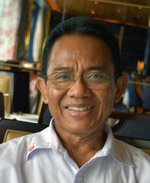
While being away from his family eight or nine months at a time, depending on the contract, can be quite difficult, the salary Oka earns as a Holland America waiter is more than he could earn in Bali. He does not have to pay for either meals or living accommodations while he is on the ship, meaning that he can send home almost all of his earnings in two remittances a month to his family.
I asked him what a typical day at sea is like for him. He responded that he usually awakens at 6 a.m., eats breakfast at 6:30 a.m. in the crew mess, then goes up to the Lido buffet where he works from 7 a.m. to 10 a.m. Thereafter he has a break until 2:30 p.m., when he serves high tea until 4 p.m. He has a 45-minute break before he reports to the Rotterdam Dining Room for two dinner seatings, usually finishing his day at 10:30 p.m. “Then I enjoy watching some TV—American TV and the BBC” in his cabin.
While the hours may seem quite long to many of us, Oka says he likes them just fine, adding that if he wasn’t working all the time, he might get bored.
When the ship is in port, there typically is an hour between breakfast and lunch during which Oka and other crew members try to find a nearby Internet café from which they can communicate with their families. Although there is Internet on the ship, it is expensive, so crew members use it sparingly.
Oka has been around the world ten times, visiting more than 100 countries. When he first started sailing, he got a little sea sick, but “after a couple of weeks I got used to it.” He said he has enjoyed “the beach at Bermuda, entering the Panama Canal and going up and down in the locks, spending three days in Hong Kong, and overnight in Rio de Janeiro.” He fondly recalls seeing Table Mountain in Cape Town, visiting Mombassa, Kenya; calling in India, crossing the Red Sea, and visiting the Middle East. “Except the countries that have no ports, I’ve been there, I’ve been there,” he enthuses.
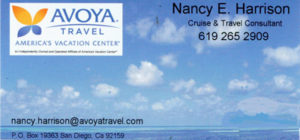 In some ports, crew members are permitted to be off the ship from 10 a.m. to 4 p.m. On such occasions, Oka likes to travel to well-known places to take a selfie of himself, even if that means taking a long bus ride there and back, without very much time to really explore the destination. He has a picture of himself at the Eiffel Tower in Paris, and at the Kotel in Jerusalem, and neither city is a port. On one world cruise, Israeli Defense Minister Moshe Dayan came aboard at the Port of Haifa, and he posed for a picture with Oka. Other celebrities that Oka has served include actors Richard Dreyfuss and Robert Duvall.
In some ports, crew members are permitted to be off the ship from 10 a.m. to 4 p.m. On such occasions, Oka likes to travel to well-known places to take a selfie of himself, even if that means taking a long bus ride there and back, without very much time to really explore the destination. He has a picture of himself at the Eiffel Tower in Paris, and at the Kotel in Jerusalem, and neither city is a port. On one world cruise, Israeli Defense Minister Moshe Dayan came aboard at the Port of Haifa, and he posed for a picture with Oka. Other celebrities that Oka has served include actors Richard Dreyfuss and Robert Duvall.
For many years, Oka had served as the emcee of the Indonesian Crew Show, which is put on for passengers at least once per cruise. Now, instead of emceeing, he narrates one of the folk dances, in which a monkey king kidnaps a human princess, who subsequently is rescued.
As a waiter, Oka is a favorite among passengers. He quickly learns passengers’ preferences, and always has a smile. I asked him what advice he would give to a young Indonesian who might want to work on a cruise ship. He responded that he would advise the youngster to perfect his English, because it is necessary if one wants to go abroad. “Hospitality means being friendly with people, talking with the people, giving good service, and a smile,” he said. “All this is natural in Indonesia; that is why the company hires us.”
Like many people from his island, Oka describes himself as Balinese Hindu, meaning that his religious practice combines both the Hinduism of India with indigenous Balinese culture. Holland America Line knows that Balinese Hindus have a religious ceremony every month at the full moon, and arranges schedules to accommodate that, even as it also arranges crew schedules to accommodate practitioners of other religions.=
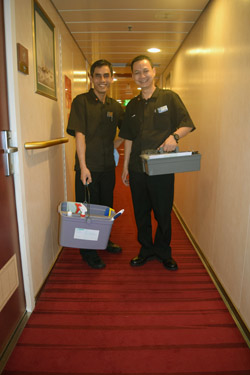
Our cabin steward, Susandri, for example, is a Muslim as are most of Indonesia’s people. He observes the practice of praying five times a day, noting that Holland America Line provides space on the ship for prayer.
Susandri grew up on the island of Java, which is the location of the country’s capital city of Jakarta. Like Oka, he went to hotel school after graduating high school. He has been with Holland America Line for 13 years, sailing on many ships of the cruise line.
Married for six years to Wulan, their son Aaikal is now 4-years-old. He said he met his wife while on home vacation from his fifth cruise ship contract. “She was in college. I met her in a shopping mall.” He tries to reach her by Internet when he goes into a port. He uses WhatsApp, so he can see her and their son.
Susandri works alongside Sugeng, who is technically his assistant, “but when we work together we are partners,” Susandri said. Together they are responsible for cleaning 30 cabins, all on the same deck. Susandri typically cleans the bedrooms and the balconies, while Sugeng cleans the bathrooms. If Sugeng finishes first, he will help Susandri complete the bedroom.
Generally, Susandri and Sugeng work from 7:30 a.m. to 2 p.m., after which they have a three-hour break which includes lunch. Then they work again from 5:30 p.m. to 9:30 p.m. The heavy cleaning is done during the morning; light cleaning, turning down the beds, and leaving towel creations for the passengers come during the evening.
Two crew members share quarters. Susandri’s is another man, not Sugeng. Because Susandri has more tenure than his roommate, he gets to choose which bunk bed he wants. He takes the lower bunk; his roommate climbs up top.
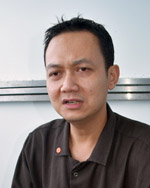
Like many crew members, Susandri was drawn to a life at sea by the opportunity to make more money and to see the world. Thanks to working on a cruise ship, he says he got to see snow fall – there is no snow in Indonesia. When possible, he likes to collect souvenirs from every country that he visits. He has souvenirs from various ports in Europe, North America, and South America as well as Australia and New Zealand. Although the ship once called in Indonesia, and his family was permitted to visit him aboard, he has not yet had the occasion to visit many other places in Asia.
Filipinos constitute another large percentage of the Maasdam’s crew, and Susandri said there are friendly interactions between the workers from the two countries. Sometimes, he said, he will greet Filipinos with a few words in their language, and they will respond with a few words in his language.
On occasion, Susandri will participate in the Indonesian Crew Show, in particular the Thousand Hands Dance, in which some dancers kneel while others rise, all the while making complimentary hand gestures.
“It’s fun when somebody makes a wrong move,” he laughs. “We only have a little time for rehearsal.”
*
Harrison is editor of San Diego Jewish World. He may be contacted via donald.harrison@sdjewishworld.com
Pingback: Touring Maasdam’s provision area, kitchen and laundry | San Diego Jewish World
Thank you for these lovely views into different worlds – both the physical you visited and the humans you met along the way! These comprehensive columns have given me insight into the locations and the people, and I truly enjoy them.